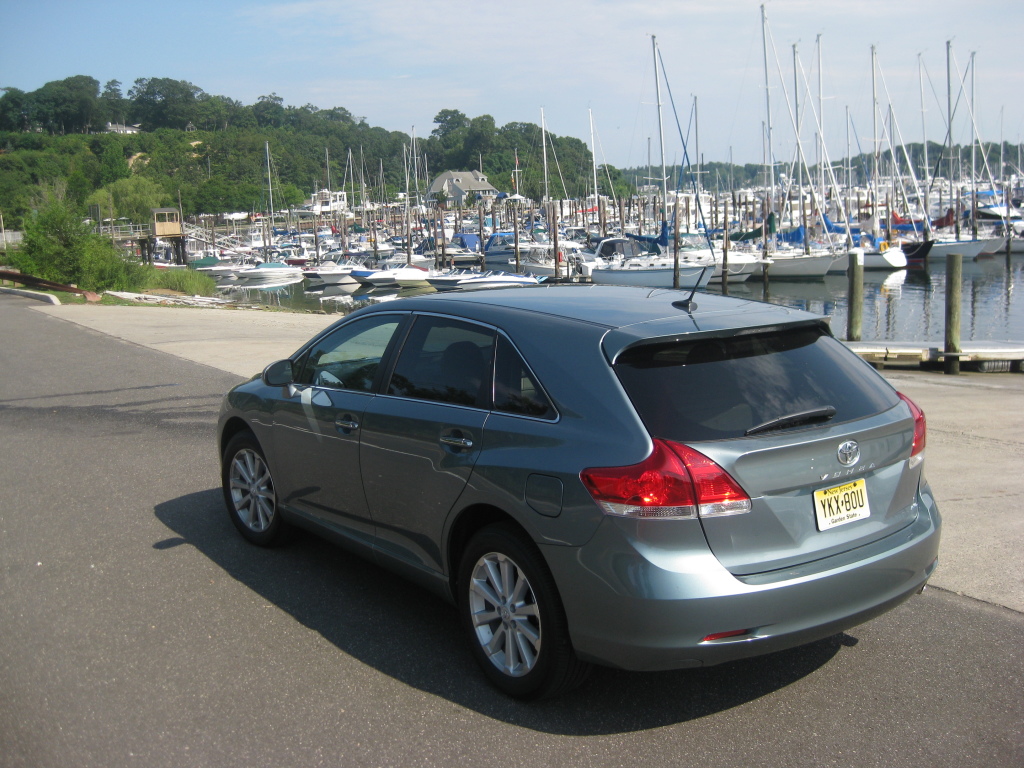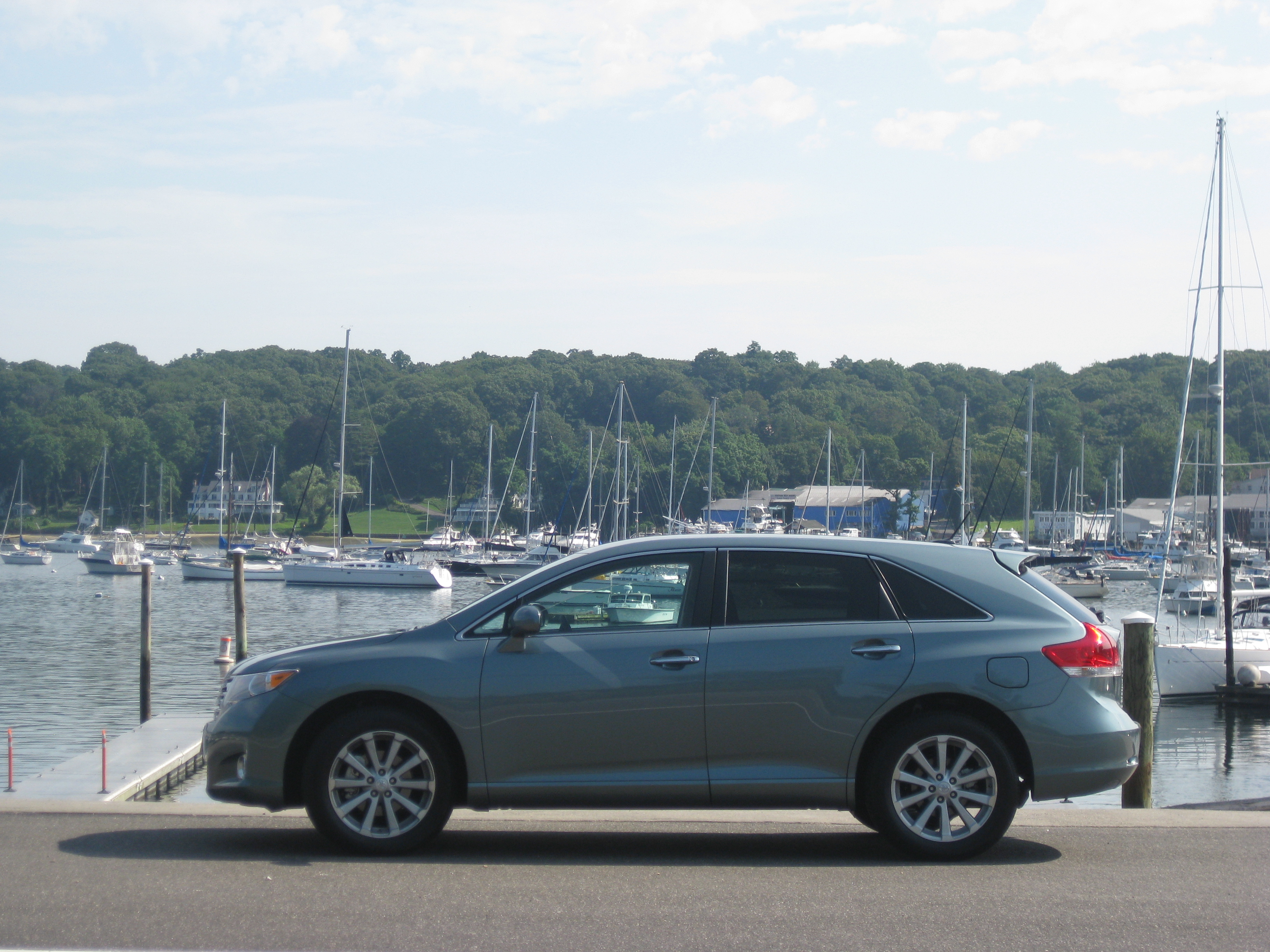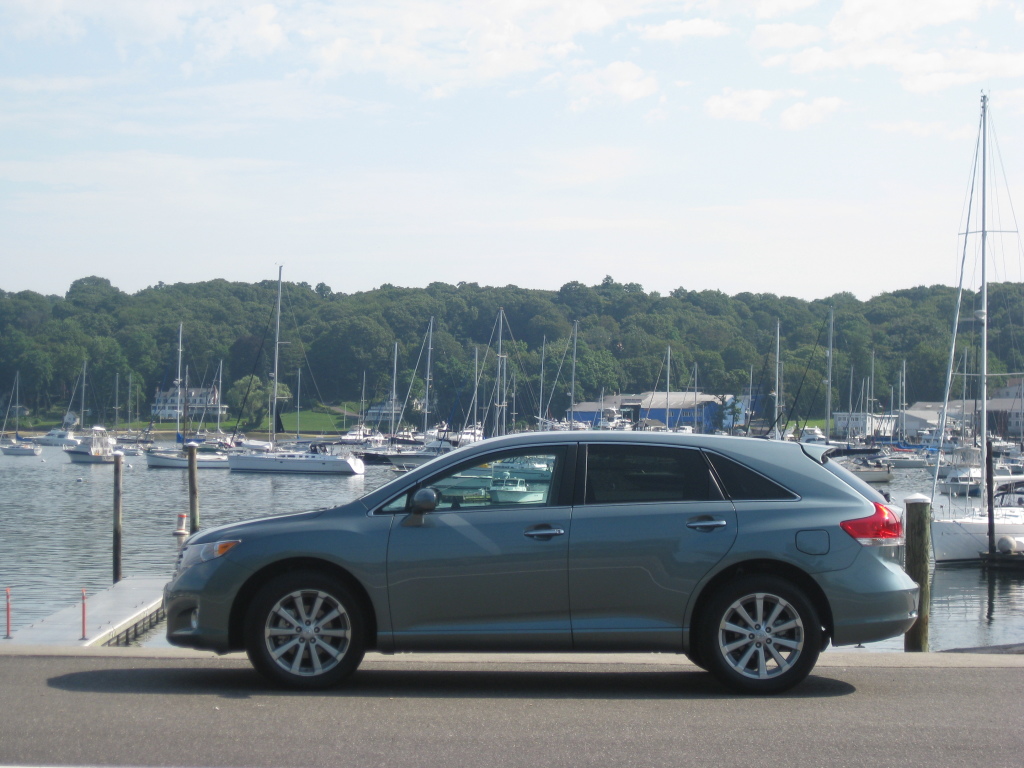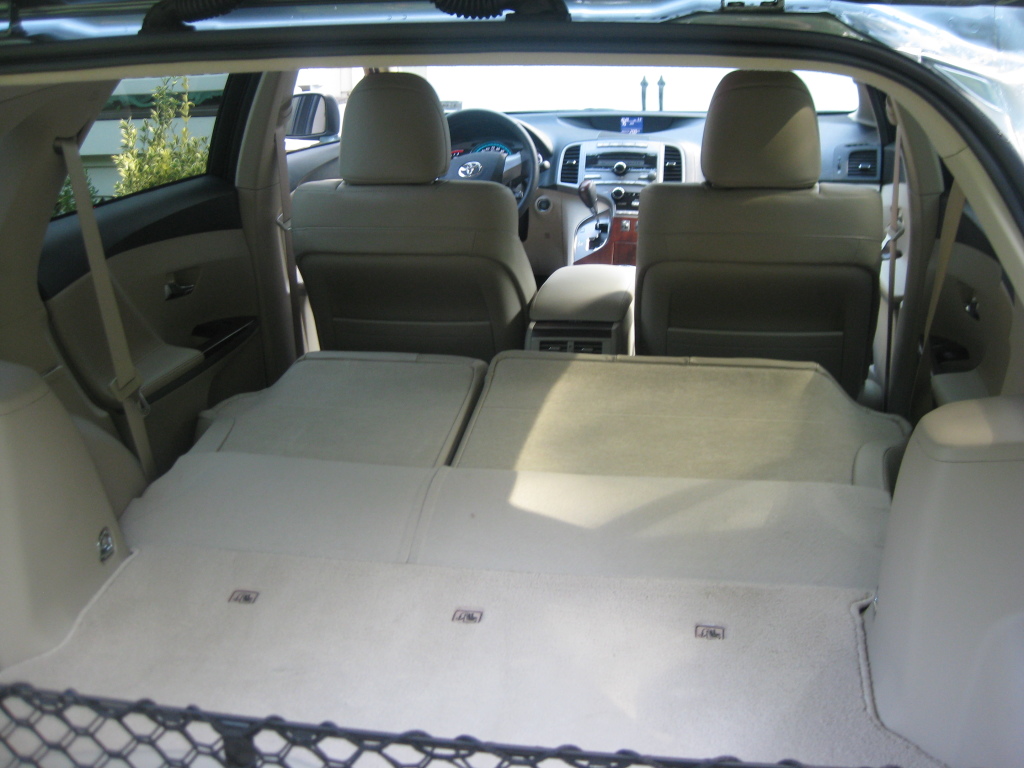When is a car not a car? When it’s the 2009 Toyota Venza. The latest addition to the brand’s line-up is something of an instigator for semantic arguments. At first look, it’s easy to tell that the Venza, though built on the (shudder) Camry platform, is more towards a small SUV in stature. You’d be in the ballpark if you hypothesized that it would fall in the crossover vehicle category, but Toyota is adamant in calling the Venza anything but a “really big car.” While magazines and other sources categorize it freely as a CUV or wagon, read the window sticker, and it’ll state “5 door sedan”. Why not call a spade a spade?
Whatever it is, the Venza is an average-looking affair, with many design cues lifted from the Lexus drawing board. There is a bulbousness about the exterior that comes into play when attempting to park, as the front is wide with a nose that dips beyond your field of vision. The grill and headlights combine for a surprisingly aggressive appearance while it maintains the uniformity of style that other Toyotas of this generation feature. Finally, around the back, you’ll find the aforementioned Lexus-styled tail lamps. There are indeed five doors, as the sticker states, if you include the rear hatch that has hands-free open and close function, the most exciting feature of the Venza.
The Venza comes with a V6 engine, but this one had the woeful 2.7L inline-4. With only 182 hp to work with, the Toyota labored constantly for momentum. This car was made for the V6, there’s no question, and having the I-4 doesn’t save you a dime, if you think that’s where the benefit would lie. First off, this car’s package was AWD, so that meant one cylinder for each wheel. Fully laden with people and cargo, I attempted to accelerate onto the highway, and while the engine whirred away as I planted my foot, there was no real change in momentum. Everything you attempt to do will demand the engine to work at full capacity, burning fuel, whereas the V6 wouldn’t work as hard, adding performance and spending just as much, if not less gas. I averaged around 20 mpg with the Venza, not a whole lot different than the V6. This engine configuration just felt unnatural and wrong. Bottom line, get the V6.
It was time for a little family excursion. Three passengers loaded themselves with ease in the rear, along with a fourth in the passenger side. While they did so, it was my job (naturally) to load towels, coolers, umbrellas and other beach-going items in the back. With a barely free hand, I pressed the button on the fob to command the back hatch to open, and with a warning squeal, it did so, allowing me to unload my arms into the back, which had plenty of room for everything and little tetris-like placement was needed. The auto-opening rear hatch is definitely a handy asset, with many well placed buttons around the car for its operation: there’s the key fob button, but there’s also a button next to the steering wheel and also one within the bottom lip of the door that you can only see when it’s open. One press, and the warning noise, an ear-piercing “squeeee!!,” announces the closing of the hatch. If you choose to ignore the cries of the Venza, as I had a brave test subject do, the hatch will sense an obstruction and reverse proceedings. In comparison to other cars that have such a feature, like the Mercedes R-class, this safety measure is quite gentle, where as the R-class will shove quite a bit before it eventually relents. The automatic movement is rapid enough that it doesn’t keep you waiting when it opens and closes, although there is a latch that has it open and close manually like a regular door if you just want to grab something quickly without standing there, pretending to be a Jedi with a sensible family vehicle.
 The rear storage is ample, with a cargo net and a pull-out shade to cover your things. If need be, both can be removed with ease, and the rear seats can be placed down with little trouble as well. I like doing the “one arm” test when it comes to family vehicles, a test that surmises that I have an arm full of things that I need to load, and I can say that the Venza gets high marks on this one. A minor nag would be that the sun shade bar, when removed then becomes an extra thing to store. Storage is the thing that this car does very well, as when you’ve finished loading it with people and cargo, you’ll find many little nooks for plenty more. All doors have cup holders sizable enough for water bottles and the center arm rest slides in various ways to reveal two voluminous buckets, as well as many smaller flip-out storage spaces, like a slender one for pens, and one that facilitates an iPod or phone. There’s even one next to the steering wheel that opens up specifically designed to be filled with toll booth money. You can easily lose things in this car, and that’s not including the glove compartment.
The rear storage is ample, with a cargo net and a pull-out shade to cover your things. If need be, both can be removed with ease, and the rear seats can be placed down with little trouble as well. I like doing the “one arm” test when it comes to family vehicles, a test that surmises that I have an arm full of things that I need to load, and I can say that the Venza gets high marks on this one. A minor nag would be that the sun shade bar, when removed then becomes an extra thing to store. Storage is the thing that this car does very well, as when you’ve finished loading it with people and cargo, you’ll find many little nooks for plenty more. All doors have cup holders sizable enough for water bottles and the center arm rest slides in various ways to reveal two voluminous buckets, as well as many smaller flip-out storage spaces, like a slender one for pens, and one that facilitates an iPod or phone. There’s even one next to the steering wheel that opens up specifically designed to be filled with toll booth money. You can easily lose things in this car, and that’s not including the glove compartment.
Interior quality is sketchy, but is fairly easy to ignore. The hard plastics have a sort of wood grain pattern about them, which does a poor job of convincing anyone visually or by touch, even if the inspection is a casual one. The long dash stretched far under the wind screen, and the tiny LCD display was mounted there, which was easy to read and within the driver’s line of sight for quick glances. It displayed outside and indoor temperature, average mpg, and all the info menus about certain functions. There is an optional navigation unit available, plus Bluetooth phone connection, although this model didn’t have these installed. It did have a 6 CD changer, AM/FM radio and MP3 player jack. This jack was placed smartly in the depths of one of the armrest storage bins, and slots were made available for the auxiliary cables to be snaked through, reducing the chance for a tangled mess. Climate control worked wonderfully and was a godsend on days like our beach adventure.
Prolonged journeys and heavy traffic are endured well in the Venza, the 19-inch wheels and independent suspension makes for a comforting ride to front and rear passengers, although road feel is sacrificed for the gentleness. Braking could have been better, as the Venza didn’t stop on a dime, it was prone to gliding past the dime altogether unless some last minute pressure was applied. And if you don’t stop in time, there are a slew of airbags to protect the front passengers, as well as knee airbags. The Venza gets near full marks in its crash test rating, losing only one star in the roll-over category, which is comforting to have in the back of your mind.
This moderately equipped, 4-cylinder AWD Venza comes to about $32,300, which would seem reasonable if the powerplant was more substantial. I started my time with the Venza feeling underwhelmed, wondering if they called it the Venza because they couldn’t call it the Toyota “meh” (the name, oddly enough is derivative of Monza, the Italian racing track. What that has to do with this car is anyone’s guess). But surprisingly, the overall comfort of the ride won me over, as well as the convenience of the interior, both in space and functionality. It nearly made the inexpensive material quality easy enough to overlook, although I’d like to see how one fares after it experiences some time and miles. It’s comfortable and spacious, and fairly average in looks, just remember that the V6 is the way to go.
Words & Photos By – Alex Kalogiannis




